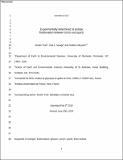Experimentally determined Si isotope fractionation between zircon and quartz
Abstract
The silicon isotope composition of detrital quartz and zircon have the potential to inform us about secular changes to the silica cycle and weathering reactions on Earth. However, inferring source melt Si isotope composition from out-of-context minerals is hampered by the fact that, to-date, there is limited Si isotope equilibrium fractionation data for minerals. Here, we report experimental data to constrain Si isotope equilibrium fractionation between zircon and quartz, using two fundamentally different strategies, but with the same experimental design. First, zircon and quartz were hydrothermally synthesized from Zr(OH)4 and SiO2 at 1.5 GPa and temperatures of 725, 800, and 900 oC. The second experimental strategy utilized the three-isotope method; the starting materials consisted of natural zircon and isotopically-labelled SiO2. Three sets of hydrothermal time-series experiments were conducted at the same pressure and temperatures as the direct synthesis experiments. For all experiments, quartz and zircon were separated and 30Si/28Si and 29Si/28Si ratios were measured by solution multi-collector inductively coupled plasma mass spectrometry. The three-isotope method, which provides the best indicator of equilibrium fractionations, yields the following relationship: Δ30Si(qtz-zrc) = (0.53±0.14) × 106 /T2 where Δ30Si(qtz-zrc) is the relative difference in 30Si/28Si between quartz and zircon in permil, T is temperature in K, and the error is 2 s.e. This relationship can be used to calculate the fractionation between zircon and other phases, and to estimate the Si isotope composition of the melt from which a zircon crystallized. The results may be used to assess equilibrium-disequilibrium isotope fractionations between quartz and zircon and co-existing phases in igneous rocks. These data can also be applied to out-of-context zircon (and quartz) to estimate the isotope composition of the host rock. Zircons crystallizing from a melt derived from purely igneous sources – i.e., without the involvement of “weathered” material – are expected to display a δ30SiNBS-28 (permil deviation of the 30Si/28Si from the NBS-28 standard) range from -0.7 to -0.35‰. Deviations from this range indicate assimilation of non-igneous (i.e., sedimentary) material in the melt source.
Citation
Trail , D , Savage , P S & Moynier , F 2019 , ' Experimentally determined Si isotope fractionation between zircon and quartz ' , Geochimica et Cosmochimica Acta , vol. 260 , pp. 257-274 . https://doi.org/10.1016/j.gca.2019.06.035
Publication
Geochimica et Cosmochimica Acta
Status
Peer reviewed
ISSN
0016-7037Type
Journal article
Description
This work was supported by NSF grants EAR-1447404 and EAR-1650033, and NERC grant NE/R002134/1. PS would also like to cite the support of a Carnegie Trust Research Incentive Grant, which helped the setup of various isotope techniques in the St Andrews Isotope Geochemistry (STAiG) laboratories. FM thanks the ERC under the European Community’s H2020 framework program/ERC grant agreement # 637503 (Pristine) and for the UnivEarthS Labex program (no. ANR-10-LABX-0023 and ANR-11-IDEX-0005-02). Parts of this work were supported by IPGP multidisciplinary program PARI, and by Region île-de-France SESAME Grant (no. 12015908).Collections
Items in the St Andrews Research Repository are protected by copyright, with all rights reserved, unless otherwise indicated.

